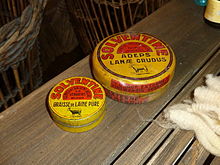
Back لانولين Arabic Ланолин Bulgarian Lanolina Catalan Lanolin Czech Lanolin Danish Wollwachs German Lanolino Esperanto Lanolina Spanish Lanolina Basque چربی پشم Persian

Lanolin (from Latin lāna 'wool', and oleum 'oil'), also called wool fat, wool yolk, wool wax, sheep grease, or wool grease, is a wax secreted by the sebaceous glands of wool-bearing animals.[1] Lanolin used by humans comes from domestic sheep breeds that are raised specifically for their wool. Historically, many pharmacopoeias have referred to lanolin as wool fat (adeps lanae); however, as lanolin lacks glycerides (glycerol esters), it is not a true fat.[2][3] Lanolin primarily consists of sterol esters instead.[4] Lanolin's waterproofing property aids sheep in shedding water from their coats. Certain breeds of sheep produce large amounts of lanolin.
Lanolin's role in nature is to protect wool and skin from climate and the environment; it also plays a role in skin (integumental) hygiene.[2] Lanolin and its derivatives are used in the protection, treatment, and beautification of human skin.[2]
- ^ Malmstrom, Ivar (1949). "Technological aspects of lanolin". Journal of Cosmetic Science. 1 (4). Archived from the original on 4 November 2021. Retrieved 4 November 2021.
- ^ a b c Hoppe, Udo, ed. (1999). The Lanolin Book. Hamburg: Beiersdorf. ISBN 9783931146054.
- ^ Barnett, G. (1986). "Lanolin and Derivatives". Cosmetics & Toiletries. 101: 21–44. ISSN 0361-4387.
- ^ Riemenschneider, W.; Bolt, H. M. "Esters, Organic". Ullmann's Encyclopedia of Industrial Chemistry. Weinheim: Wiley-VCH. doi:10.1002/14356007.a09_565.pub2. ISBN 978-3527306732.
© MMXXIII Rich X Search. We shall prevail. All rights reserved. Rich X Search